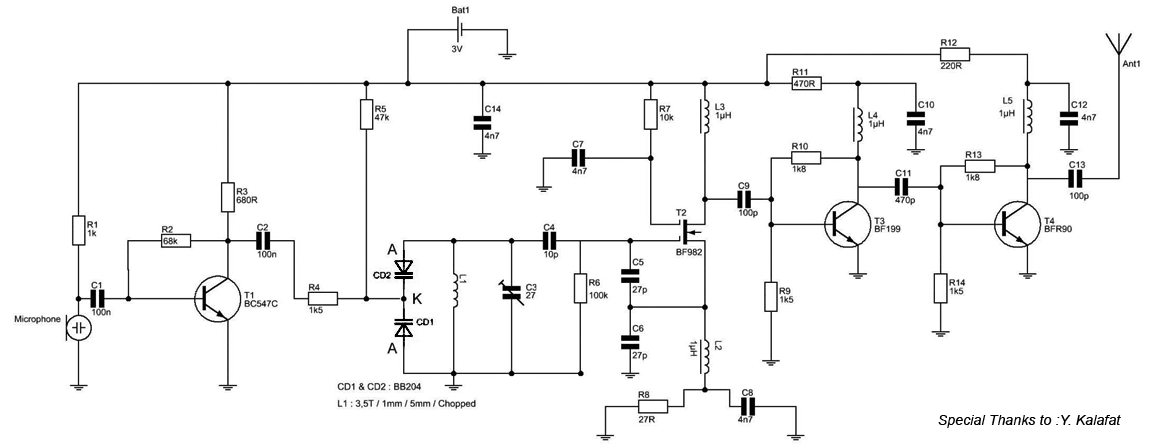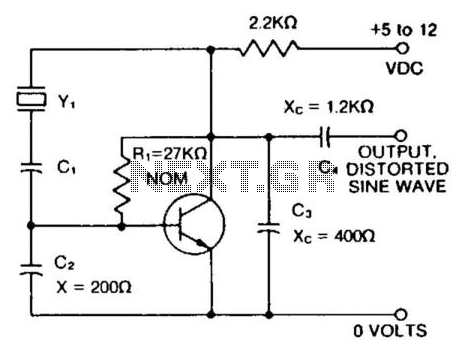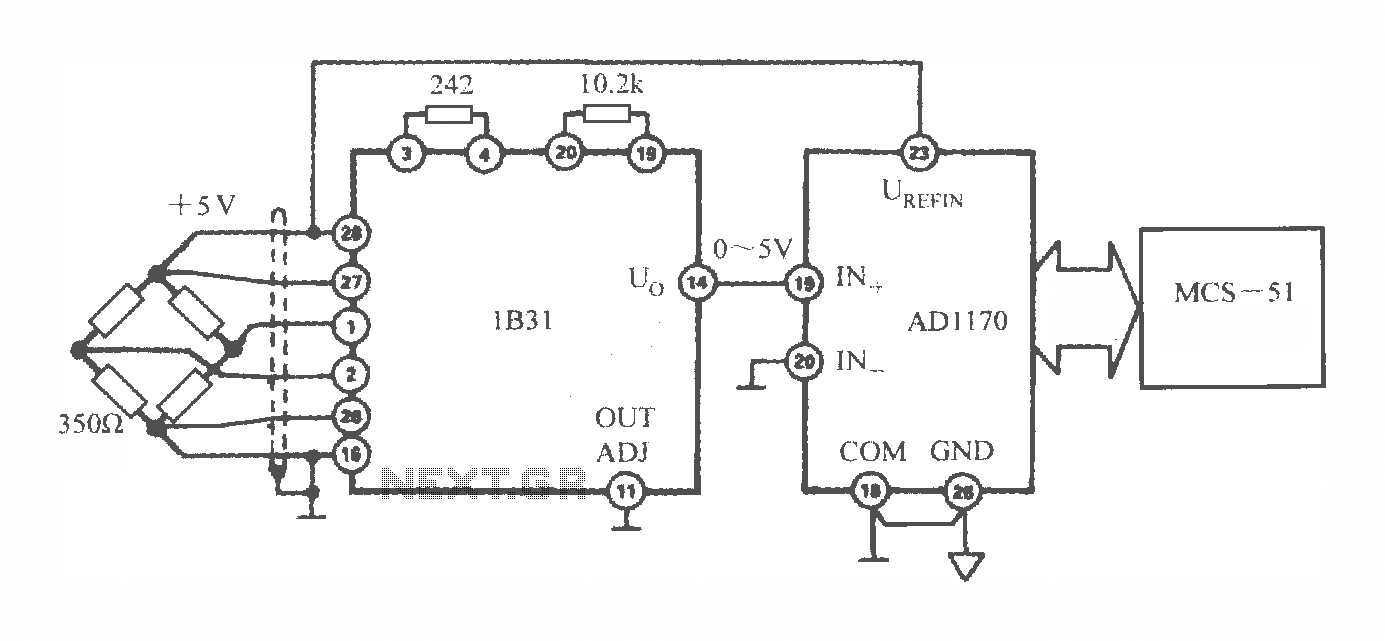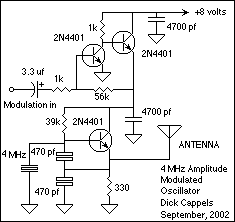
The Ecology of the Oscillator Transmitter
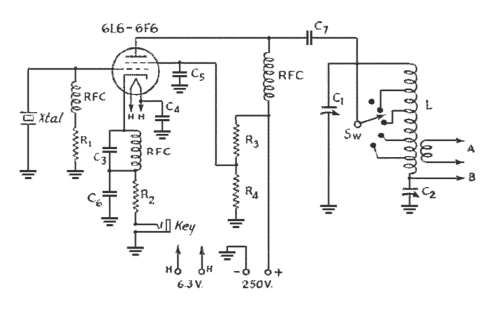
An oscillator-only transmitter appears to be the simplest way to access the radio airwaves; however, it presents several challenges as part of a transmitting and receiving station. The issue of finding an adequate crystal-controlled transmitter for newcomers wishing to operate on continuous wave (CW) has not been effectively resolved for amateurs with limited budgets. Most beginners now utilize some form of a keyed crystal oscillator directly connected to the antenna system. The outcomes of this setup are well-known. If the crystal is not of the highest quality and most active type, the power output is minimal. Conversely, if the crystal is particularly active, it can yield a respectable power output, but issues such as undesirable keying chirps may arise, and rapid keying can lead to missing dots. Additionally, the transmitter may become temperamental after periods of inactivity, requiring retuning before it will key properly. In cases where the crystal operates effectively and keys cleanly, there is a temptation to increase the plate voltage to boost power output. This approach can lead to problems if the antenna becomes uncoupled, often resulting in the need for a new crystal close to the frequency of the previous one. The typical beginner's transmitter is designed around a single tube, based on the idea that multiple stages would complicate or increase costs. This often results in a transmitter with critical antenna coupling adjustments needed to balance maximum output with reliable, chirp-free keying. Additionally, attempts to compensate for the absence of extra power stages often involve running the oscillator at high input power, which risks crystal damage. Many experienced users of high-power oscillators conclude that most issues could be avoided if the oscillator, whether crystal or self-controlled, is treated primarily as a frequency-control unit, with power output being a secondary concern. Those who have operated single-tube transmitters understand the complexities involved. While single-tube 6L6 rigs may seem simple in theory and easy to construct, practical operation reveals that simplicity often ends there. Oscillators can exhibit unpredictable behavior when connected to an antenna, and experience indicates that isolating the oscillator from the antenna is the best way to prevent issues. Keying an oscillator should be approached cautiously if a clean signal free from disturbances is desired. However, keying is necessary for break-in operation to work near one's own frequency, which is essential for effective communication today. Most crystal oscillators require careful tuning adjustments to key properly. The Tri-tet and grid-plate circuits can key effectively without critical tuning adjustments, provided the output circuit is tuned to a harmonic of the crystal frequency. However, many crystal oscillators in 3.5 MHz transmitters operate at the fundamental frequency of the crystal, where regenerative circuits may introduce complications.
The oscillator-only transmitter serves as a fundamental building block for amateur radio operators, particularly those who are just starting. Its design simplicity, centered around a single tube, offers an accessible entry point for newcomers. However, this simplicity masks the inherent challenges of achieving reliable performance, particularly in terms of power output and keying fidelity. The coupling of the oscillator to the antenna circuit is crucial, as it directly influences the transmitter's ability to deliver usable power while maintaining a clean signal.
When designing such a transmitter, careful selection of the crystal is essential. High-quality crystals not only provide better frequency stability but also enhance the overall performance of the oscillator. The oscillator's output stage must be designed to accommodate the specific characteristics of the chosen crystal, ensuring that it operates efficiently without risking damage due to excessive power levels.
Furthermore, the implementation of isolation techniques between the oscillator and the antenna is advisable to mitigate the risk of oscillation instability and to enhance signal clarity. This can involve the use of buffer amplifiers or additional filtering stages that can help maintain a clean signal while allowing for necessary power adjustments.
Keying mechanisms should be designed to minimize the introduction of chirps and other unwanted artifacts. This can be achieved through careful circuit design, including the use of keying relays or electronic keyers that provide smoother transitions. The tuning of the output circuit to harmonics of the crystal frequency can also improve keying performance, allowing for more reliable operation during rapid keying sequences.
In conclusion, while the oscillator-only transmitter presents an inviting option for novice radio operators due to its simplicity, it requires a thoughtful approach to design and operation to overcome the challenges associated with power output, keying fidelity, and overall reliability.An oscillator-only transmitter sounds like the simplest possible means of getting on the radio air ”until you consider the challenges it presents as part of the system that is a transmitting and receiving station: The problem of an adequate crystal-controlled transmitter for the newcomer who wishes to come on the air for the first time on c. w. ha s never been very effectively solved for the amateur who has but a small amount of capital to invest in the first rig. The majority of the beginners now coming on the air use some type of a keyed crystal oscillator coupled directly to the antenna system.
We all well know the results of this kind of operation. If the crystal is anything but the very best and most active type, the arrangement is capable of almost no usable power output. If the crystal happens to be an especially active one, it will be possible to obtain a respectable amount of power output but bad keying chirps are likely to be present, dots are very often not present if rapid keying is used, or the rig may frequently become temperamental after having lain idle for a few hours or days and refuse to key at all until it is retuned.
Then, if the crystal does operate well and key cleanly, there is always the temptation to raise the plate voltage to increase the power output. This may be fine until the antenna accidently or intentionally becomes uncoupled some fine day with the result that we will usually be in the immediate market for another crystal "as close as possible to the frequency of the last one.
" ”Jack Rothman, W6KFQ, "The Newcomer`s Special, " Radio, October 1938, pages 38 40 and 66. The usual beginner`s transmitter is built around a single tube, following the premise that more than one stage will make the first step too complicated or too expensive. The frequent result is a transmitter whose coupling to the antenna circuit is critical in adjustment for a compromise between maximum output and reliable, chirp-free keying.
To make matters worse, an attempt is usually made to make up for the lack of additional power stages by running the oscillator at high-power input, incurring the danger of crystal fracture as well. Almost everyone who has had experience with high-power oscillators eventually comes around to the oft-voiced conclusion that more troubles would be avoided if the oscillator, be it crystal or self-controlled, is treated as a frequency-control unit with power output of decidedly secondary importance.
”Don Mix, W1TS, "A Fool-Proof Rig for 80 and 40 meters, " QST, June 1941, pages 20 23. If you`ve ever juggled both a single-tube transmitter and an antenna, you`ll know what this is all about before we begin. But if you haven`t, and are searching for something "simple, " look before you leap! Yes, those single-tube 6L6 rigs look awfully simple on paper. And they are just as simple to build. If you`ve ever operated one, however, you know that simplicity ends right there. Oscillators have a way of misbehaving when coupled to an antenna, and experience has shown that the only way to eliminate all possibility of trouble is to isolate the oscillator from the antenna.
”Richard M. Smith, W1FTX, "A Beginner`s CW Transmitter, " QST, May 1948, pages 25 30. The keying of an oscillator is something to be avoided if you want to have a signal free from "yoops" and "chirps. " Unfortunately, however, the oscillator must be keyed for break-in operation if you want to work near your own frequency, which seems to be the only way to work anyone these days.
Most crystal oscillators do not key well unles care is exercised in adjusting their tuning. The Tri-tet and grid-plate circuits key well without critical adjustment as long as the output circuit is tuned to a harmonic of the crystal frequency. However, most crystal oscillators in 3. 5-Mc. transmitters are being operating at the crystal fundamental frequency and under this condition the regenerative circuits hav
🔗 External reference
The oscillator-only transmitter serves as a fundamental building block for amateur radio operators, particularly those who are just starting. Its design simplicity, centered around a single tube, offers an accessible entry point for newcomers. However, this simplicity masks the inherent challenges of achieving reliable performance, particularly in terms of power output and keying fidelity. The coupling of the oscillator to the antenna circuit is crucial, as it directly influences the transmitter's ability to deliver usable power while maintaining a clean signal.
When designing such a transmitter, careful selection of the crystal is essential. High-quality crystals not only provide better frequency stability but also enhance the overall performance of the oscillator. The oscillator's output stage must be designed to accommodate the specific characteristics of the chosen crystal, ensuring that it operates efficiently without risking damage due to excessive power levels.
Furthermore, the implementation of isolation techniques between the oscillator and the antenna is advisable to mitigate the risk of oscillation instability and to enhance signal clarity. This can involve the use of buffer amplifiers or additional filtering stages that can help maintain a clean signal while allowing for necessary power adjustments.
Keying mechanisms should be designed to minimize the introduction of chirps and other unwanted artifacts. This can be achieved through careful circuit design, including the use of keying relays or electronic keyers that provide smoother transitions. The tuning of the output circuit to harmonics of the crystal frequency can also improve keying performance, allowing for more reliable operation during rapid keying sequences.
In conclusion, while the oscillator-only transmitter presents an inviting option for novice radio operators due to its simplicity, it requires a thoughtful approach to design and operation to overcome the challenges associated with power output, keying fidelity, and overall reliability.An oscillator-only transmitter sounds like the simplest possible means of getting on the radio air ”until you consider the challenges it presents as part of the system that is a transmitting and receiving station: The problem of an adequate crystal-controlled transmitter for the newcomer who wishes to come on the air for the first time on c. w. ha s never been very effectively solved for the amateur who has but a small amount of capital to invest in the first rig. The majority of the beginners now coming on the air use some type of a keyed crystal oscillator coupled directly to the antenna system.
We all well know the results of this kind of operation. If the crystal is anything but the very best and most active type, the arrangement is capable of almost no usable power output. If the crystal happens to be an especially active one, it will be possible to obtain a respectable amount of power output but bad keying chirps are likely to be present, dots are very often not present if rapid keying is used, or the rig may frequently become temperamental after having lain idle for a few hours or days and refuse to key at all until it is retuned.
Then, if the crystal does operate well and key cleanly, there is always the temptation to raise the plate voltage to increase the power output. This may be fine until the antenna accidently or intentionally becomes uncoupled some fine day with the result that we will usually be in the immediate market for another crystal "as close as possible to the frequency of the last one.
" ”Jack Rothman, W6KFQ, "The Newcomer`s Special, " Radio, October 1938, pages 38 40 and 66. The usual beginner`s transmitter is built around a single tube, following the premise that more than one stage will make the first step too complicated or too expensive. The frequent result is a transmitter whose coupling to the antenna circuit is critical in adjustment for a compromise between maximum output and reliable, chirp-free keying.
To make matters worse, an attempt is usually made to make up for the lack of additional power stages by running the oscillator at high-power input, incurring the danger of crystal fracture as well. Almost everyone who has had experience with high-power oscillators eventually comes around to the oft-voiced conclusion that more troubles would be avoided if the oscillator, be it crystal or self-controlled, is treated as a frequency-control unit with power output of decidedly secondary importance.
”Don Mix, W1TS, "A Fool-Proof Rig for 80 and 40 meters, " QST, June 1941, pages 20 23. If you`ve ever juggled both a single-tube transmitter and an antenna, you`ll know what this is all about before we begin. But if you haven`t, and are searching for something "simple, " look before you leap! Yes, those single-tube 6L6 rigs look awfully simple on paper. And they are just as simple to build. If you`ve ever operated one, however, you know that simplicity ends right there. Oscillators have a way of misbehaving when coupled to an antenna, and experience has shown that the only way to eliminate all possibility of trouble is to isolate the oscillator from the antenna.
”Richard M. Smith, W1FTX, "A Beginner`s CW Transmitter, " QST, May 1948, pages 25 30. The keying of an oscillator is something to be avoided if you want to have a signal free from "yoops" and "chirps. " Unfortunately, however, the oscillator must be keyed for break-in operation if you want to work near your own frequency, which seems to be the only way to work anyone these days.
Most crystal oscillators do not key well unles care is exercised in adjusting their tuning. The Tri-tet and grid-plate circuits key well without critical adjustment as long as the output circuit is tuned to a harmonic of the crystal frequency. However, most crystal oscillators in 3. 5-Mc. transmitters are being operating at the crystal fundamental frequency and under this condition the regenerative circuits hav
🔗 External reference
